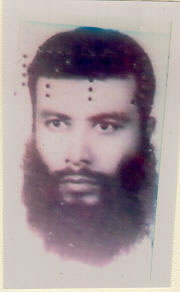August 3, 2008 | FDD’s Long War Journal
Al Qaeda confirms WMD expert Abu Khabab killed in South Waziristan strike
 |
|
Abu Khabab, via the US Rewards for Justice website. |
Al Qaeda has confirmed that Abu Khabab al Masri, the chief of the terror group's weapons of mass destruction program, was killed in an airstrike in South Waziristan earlier this week.
Khabab was one of the most wanted terrorists due to his experience, seniority, and expertise with bomb-making and chemicals and poisons. The US Rewards for Justice Program has a $5 million bounty out for the capture of Khabab.
Al Qaeda posted a statement on the network of jihadi web forums announcing Khabab's death, Reuters reported. The statement was signed by Mustafa Abu Yazid, al Qaeda's senior leader in Afghanistan. Yazid said Khabab left behind a multitude of followers trained to strike at the West.
The US military killed Khabab during a targeted strike on an al Qaeda safe house in the village of Zeralita in the Azam Warsak region of South Waziristan on July 28. At least three foreigner terrorists were reported among the six killed in the airstrike.
Ayman al Zawahiri, al Qaeda's second in command, is rumored to have been killed in the South Waziristan strike. But the reports are unconfirmed and the Taliban denied Zawahiri was anywhere near the site of the attack. US intelligence believes the reports are not credible.
Khabab is the third senior al Qaeda leader to have perished in Pakistan's lawless tribal regions.
On May 14, Abu Sulayman Jazairi, a senior Algerian operative for al Qaeda' s central organization who directed the groups external operations, was killed in an airstrike against a Taliban and al Qaeda safe house in the town of Damadola in Pakistan' s Bajaur tribal agency along with 13 associates. Jazairi is described as a senior trainer, an explosives expert, and an operational commander tasked with planning attacks on the West.
Abu Laith al Libi was killed in a US strike inside the North Waziristan tribal agency in Pakistan in late January. Al Libi was the leader of the Libyan Islamic Fighting Group and served as a chief spokesman for al Qaeda. Laith also commanded al Qaeda forces in Afghanistan.
The US military has carried out at least three other strikes against al Qaeda and Taliban targets in the tribal areas this year. These hits include a strike that targeted Baitullah Mehsud in his hometown of Makeen on June 14, an attack on a compound run by Siraj Haqqani on March 16, and the bombing of a fortified fortified compound owned by Noorullah Wazir on March 12.
Background on Abu Khabab
Khabab has a long history of working with al Qaeda's secretive weapons of mass destruction program, which is known as al Zabadi, or 'œcurdled milk.”
Khabab “operated a terrorist training camp at Derunta, Afghanistan where he provided hundreds of Mujahidin with hands-on training in the use of poisons and explosives,” the Rewards for Justice Website states. “Since 1999, he has distributed training manuals that contain instructions for making chemical and biological weapons. Some of these training manuals were recovered by U.S. forces in Afghanistan.”
Dan Darling reported on Khabab's history with the Egyptian military and al Qaeda for The Long War Journal in September 2005.
A former scientist in the Egyptian chemical weapons program, Khabab, turned against the government of Anwar Sadat. Khabab joined Ayman al Zawahiri's Egyptian Islamic Jihad, where he served as an explosives expert and poison trainer for the group.
After Egyptian Islamic Jihad merged with al Qaeda, he became the head of Project al Zabadi. The program largely focused on chemical and biological weapons, and devices to disperse the agents. Evidence of Project al Zabadi's operations has turned up throughout Afghanistan, Iraq, the Middle East, North Africa, and Europe.
The US military has targeted Khabab in the past. Abu Khabab and four other senior al Qaeda commanders were reported to have been killed in an airstrike in the town of Damadola in the Bajaur tribal agency in January 2006. The US military believed the safe house in Bajaur, which was run by Taliban chieftain Faqir Mohammed, was sheltering Ayman al Zawahiri, al Qaeda's second in command. Khabab and the other commanders were later found to be still alive.
For more information on Abu Khabab and al Qaeda's weapons of mass destruction program, see:
'¢ Abu Khabab and Project al Zabadi – The Long War Journal
'¢ Al Qaeda's Mad Scientist – The Weekly Standard